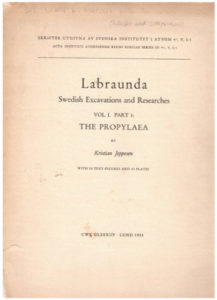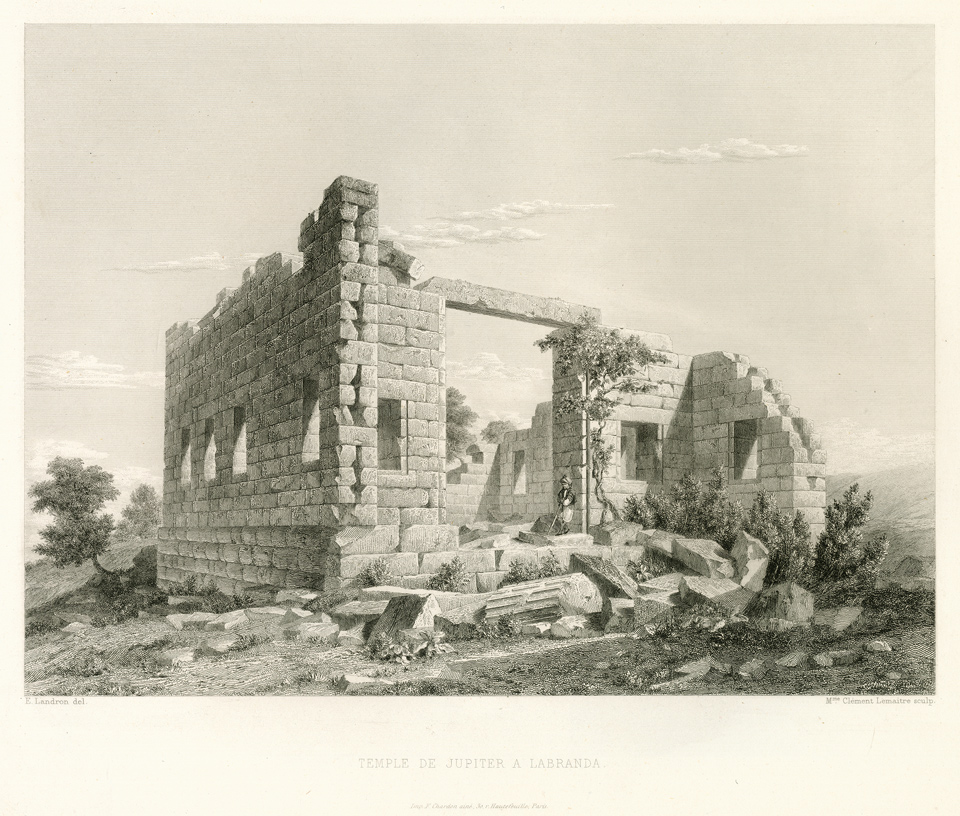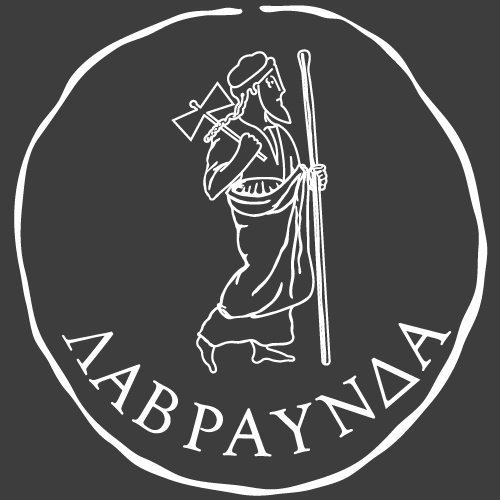Sources et Publications
Les publications ayant pour objet le site de Labraunda sont nombreuses. Depuis le premier volume paru en 1955, sur les propylées, jusqu’à celui consacré au andrônes, en 2019, ce sont plus de 15 monographies ou ouvrages collectifs qui ont été publiés. Quant aux notes, articles et rapports, les références données ici ne sauraient être exhaustives, tant la production scientifique est abondante.
Les prochaines publications prévues sont les suivantes :
- Le projet hékatomnide à Labraunda
- Les nécropoles de Labraunda
- Les fortifications de Labraunda
- Le territoire de Labraunda
- La fontaine hypostyle de Labraunda

Rapports préliminaires
Les voyageurs
Le site de Labraunda, bien qu’il apparaisse régulièrement dans les sources antiques, ne fut redécouvert par les savants modernes qu’à partir du second tiers du XIXe siècle. Les premiers travaux de relevés menés sur le site l’ont été par un Français, Philippe Le Bas, membre de l’Académie des Inscriptions et Belles Lettres, qui fut mandaté par le ministre de l’instruction publique afin de mener une expédition épigraphique en Grèce et en Asie Mineure.
Philippe Le Bas visita le site de Labraunda le 17 mars 1844. Un extrait d’un courrier, publié dans le numéro de mai-juin 1844 de la Revue Indépendante, révèle la fascination que le sanctuaire exerça sur le savant : « J’avais enfin rencontré l’objet de mes fatigantes recherches : j’étais bien à Labranda. Strabon dit que le temple de Jupiter Stratius, dans ce lieu, était fort ancien. Tout, dans les ruines de celui de Yaïla, annonce une haute antiquité. Il ne ressemble en rien à tous ceux que j’ai vus jusqu’à ce jour ».

Les autres voyageurs qui visitèrent le site de Labraunda au XIXe s. sont les suivants :
- William M. Leake, Journal of a tour in Asia Minor with comparative remarks on the ancient and modern geography of that country, London 1824.
- Anton Prokesch von Osten, Mittheilungen aus Kleinasien (Schluß). II. Reise von Halikarnassos über Mylasa und Tralles nach Smyrna. April 1827’, Anzeige-Blatt für Wissenschaften und Kunst, 59, 1832, 4f.
- Anton Prokesch von Osten, Denkwürdigkeiten und Erinnerungen aus dem Orient, Stuttgart 1836-7.
- Anonymous [Hermann Pückler-Muskau], Die Rückkehr. Vom Verfasser der Briefe eines Verstorbenen, III, Berlin 1848.
- Charles Fellows, An account of discoveries in Lycia: being a journal kept during a second excursion in Asia Minor, London 1852.
- W.H. Waddington, Voyage en Asie-Mineure au point de vue numismatique, Paris 1853.
- Philippe Le Bas, Voyage archéologique en Grèce et en Asie Mineure sous la direction de M. Philippe Le Bas (1842-1844), Paris 1847-1870.
- C.T. Newton, A History of Discoveries at Halicarnassus, Cnidus and Branchidae, London 1862.
- Philippe Le Bas, Voyage archéologique en Grèce et en Asie Mineure sous la direction de M. Philippe Le Bas (1842-1844). Planches de topographie, de sculpture et d’architecture, gravées d’après les dessins de E. Landron, publiées et commentées par Salomon Reinach, Paris 1888, 47-48.
Monographies et Ouvrages collectifs
Dans la série Swedish Research at Labraunda
Vol. I:1. K. Jeppesen, The Propylaea, Lund 1955.
Vol. I:2. A. Westholm, The architecture of the Hieron, Lund 1963.
Vol. I:3. P. Hellström & Thomas Thieme, The Temple of Zeus, Stockholm 1982.
Vol. II:1. P. Hellström, Pottery of Classical and Later Date, Terracotta Lamps and Glass, Lund 1965.
Vol. II:2. M.L. Säflund, Stamped Amphora Handles, Stockholm 1980.
Vol. II:3. J.J. Jully, Archaic Pottery, Stockholm 1981.
Vol. II:4. M. Meier-Brügger, Die karischen Inschriften, Stockholm 1982.
Vol. II:5. A.C. Gunter, Marble Sculpture, Stockholm 1995.
Vol. III:1. J. Crampa, The Greek Inscriptions, part 1, Lund 1969.
Vol. III:2. J. Crampa, The Greek Inscriptions, part 2, Stockholm 1972.
Vol. IV. J. Blid, Remains of Late Antiquity, Stockholm 2016.
Vol.V. P. Hellström, J. Blid, The andrones, Stockholm 2019.
Ouvrages collectifs
F. Kuzucu, Ural, M. (éds.), Mylasa Labraunda – Milas Çomakdağ, Istanbul 2010.
L. Karlsson, Carlsson, S. (éds)., Labraunda and Karia. Proceedings of the international symposium commemorating sixty years of Swedish archaeological work in Labraunda. The Royal Swedish Academy of Letters, History and Antiquities, Stockholm, November 20-21, 2008 (Boreas 32), Uppsala 2011.
L. Karlsson, S. Carlsson & J. Blid Kullberg (eds.), LABRYS, Studies presented to Pontus Hellstrom [Boreas 35], Uppsala 2014.
Guide archéologique
Hellström, P., Labraunda. A Guide to the Karian Sanctuary of Zeus Labraundos, Istanbul 2007.
Monographie
Henry, O., Le projet hékatomnide à Labraunda, à paraître.
Articles et Notes
Vous trouverez, ci-dessous, une liste non-exhaustive d’articles concernant le site de Labraunda:
- Blid, J., « New Research on Carian Labraunda in Late Antiquity », Opuscula Atheniensia, 31-32, 2006-2007, 231-252.
- Blid, J., “The Andron of Maussollos at Labraunda and its architectural sculpture”, in A. Dahlén (éd.), Achaemenid Anatolia. BOREAS, Uppsala Studies in Ancient Mediterranean and Near Eastern Civilizations, Uppsala (forthcoming).
- Blid, J., “Anta construction and design in the Hekatomnid building programme”, in P. Pedersen & B. Poulsen (éds.), Karia and the Dodekanese: Cultural interrelations in the south-eastern Aegean ca. 500 BC–AD 500 , Oxford (forthcoming).
- Blid, J., “Architectural polychromy at Hekatomnid Labraunda”, in M. Mulliez (éd.), Restituer les couleurs. Le rôle de la restitution dans les recherches sur la polychromie en sculpture, architecture et peinture mural, Bordeaux (forthcoming).
- Çakmaklı, Ö.D., “Labraunda Su Kompleksi Kazıları ve ince Cidarlı Seramigi ( Ön Rapor)/ The Thin Walled Pottery from the Excavation at Labraunda Water Complex (Preliminary Report)”, Pamukkale University Journal of Social Sciences Institute 28, 2017, 257-269.
- Çakmaklı, Ö., “Labraunda’nın Yeni Bilmecesi : Su Kompleksi Kazıları 2013-2015 Kazı Sezonu Degerlendirmesi / The Mistery of Labraunda: Water Complex Excavations”, Journal of History Culture and Art Research 5.3, September 2016, 15-25.
- Çakmaklı, Ö., “Zeus Labraundos Kutsal Alanı Su Kompleksi Kazıları Cam Buluntuları / Glass Finds from Water Complex in the Sanctuary of Zeus Labraundos”, Seleucia VII, 2017, 279-297.
- Frejman, A., “En måndag vid Zeus helgedom”, Nya Populär Arkeologi 1, 2016, 30-31.
- Frejman, A., “Some thoughts on ancient maps, travel, and the location of Greek rural sanctuaries”, Thiasos 7.2, 2018, 101-110.
- Dahlén, I., « Fragments of a kline from Labranda », Opuscula Atheniensia 2, 1955, 37-46.
- Gunter, A.C., « Looking at Hecatomnid patronage from Labraunda », Revue des études anciennes 87, 1985, 113-124.
- Gunter, A.C., « Sculptural dedications at Labraunda », Architecture and Society in Hecatomnid Caria, Uppsala 1989, 91-98.
- Hellström, P., « Dessin d’architecture hécatomnide à Labraunda », Le dessin d’architecture dans les sociétés antiques, Leiden 1985, 153-165.
- Hellström, P., « Labraunda. Mixed orders in Hecatomnid architecture », Proceedings of the 12th International Congress of Classical Archaeology. Athens 4-10 September 1983, Athènes 1988, 70-74.
- Hellström, P., « Formal Banqueting at Labraunda », Architecture and Society in Hecatomnid Caria, Uppsala 1989, 99-104.
- Hellström, P., « Hellenistic architecture in the light of Late Classical Labraunda », Akten des 13. Internationalen Kongresses für Klassische Archäologie. Berlin 1988, Mainz am Rhein 1990, 243- 252.
- Hellström, P., « The architectural layout of Hekatomnid Labraunda », Revue archéologique 1991, 297-308.
- Hellström, P., « Architecture. Characteristic building-types and particularities of style and technique. Possible implications for Hellenistic architecture », in Hekatomnid Caria and the Ionian renaissance, ed. J. Isager (Halikarnassian Studies, 1), Odense 1994, 36-57.
- Hellström, P., « Columns, what are you up to? », Opus Mixtum. Essays in ancient art and society (Acta of the Swedish Institute at Rome, 21), Stockholm 1994, 53-56.
- Hellström, P., « Maussollos and his ambitions », in The illustrated history of humankind 3. Old world civilizations, ed. G. Burenhult, McMahons Point and Höganäs 1994, 155-157.
- Hellström, P., « Hecatomnid display of power at the Labraynda sanctuary », in P. Hellström & B. Alroth (éds.), Religion and power in the ancient Greek world, Uppsala 1996, 133-138.
- Hellström, P., « The Andrones at Labraynda. Dining halls for Protohellenistic kings », in W. Hoepfner & G. Brands (éds.), Basileia. Die Paläste der Hellenistischen Könige, Mainz 1996, 164- 169.
- Hellström, P., « Sculpture from Labraynda », in I. Jenkins & G.B. Waywell, Sculptors and Sculpture of Caria and the Dodecanese, London 1997, 109-113.
- Hellström, P., « 100 years of Swedish excavations in Turkey, and a bibliography », in Accurata Descriptio, Stockholm 2003, 237-252.
- Hellström, P., « Sacred architecture and Karian identity », in F. Rumscheid (éd.), Die Karer und die Anderen. Internationales Kolloquium an der Freien Universität Berlin 13. bis 15. Oktober 2005, Bonn 2009, 267-290.
- Hellström, P., « Labraunda. The rediscovery » in L. Karlsson & S. Carlsson (éds.), Labraunda and Karia (Boreas 32), Uppsala 2011, 19-47 .
- Hellström, P., « Feasting at Labraunda and the chronology of the Andrones », in L. Karlsson & S. Carlsson (éds.), Labraunda and Karia (Boreas 32), Uppsala 2011, 149-157.
- Hellström, P., « Labraunda bibliography 1948-2010″, in L. Karlsson & S. Carlsson (éds.), Labraunda and Karia (Boreas 32), Uppsala 2011, 149-157.
- Hellström, P., « A Cultic Theatre at Karian Labraunda », in S. Faust, M. Seifert, L. Ziemer (éds.), Antike. Architektur. Geschichte Festschrift für Inge Nielsen zum 65. Geburtstag, Aachen 2015, 107-120.
- Hellström, P., « Early Labraunda, Excavations on the Temple terrace 1949-1953 », in O. Henry, K. Konuk (éds.), Karia Arkhaia, Istanbul 2019, 61-88.
- Hellström, P., Thieme, Th., « The Temple of Zeus at Labraunda. A preliminary note », Svenska Forskningsinstitutet i Istanbul. Meddelanden 4, 1979, 5-26.
- Hellström, P., Thieme, Th., « The Androns at Labraunda. A preliminary account of their architecture », Medelhavsmuseet. Bulletin 16, 1981, 58-74.
- Henry, O., « Remarques sur le propriétaire de la tombe monumetale de Labraunda », Revue des Etudes Anciennes 108.2, 2006, 415-432.
- Henry, O., « Traditions funéraires cariennes », Les Dossiers d’Archéologie, 2008.
- Henry, O., « Wood Reflections on Stone Tombs in Southwest Asia Minor », in L. Summerer & A. von Kienlin (eds.) Tatarli, the Return of Colours, Istanbul, 2010, 296-315.
- Henry, O., « The Pi shape tomb from Labraunda and Karian parallels”, in L. Karlsson and S. Carlsson (éds.), Labraunda and Karia, Uppsala 2011, 159-176.
- Henry, O., Ingvarsson-Sundstrom, A., “The story of a tomb at Labraunda”, in L. Karlsson, Carlsson, S. (éds.), Labraunda and Karia, Uppsala 2011, 177-198.
- Henry, O., « Le Sanctuaire de Labraunda. Historique, état des lieux et perspectives de recherche”, Anatolia Antiqua XX, 2012, 227-260.
- Henry, O., « Tombes cariennes, tombes lyciennes : un processus analogue de pétrification architecturale?”, in P. Brun, L. Cavalier, K. Konuk et F. Prost (éds.), Euploia. La Lycie et la Carie Antiques, Bordeaux, 2013, 257-270.
- Henry, O., « Then whose Tomb is That?”, in L. Karlsson, S. Carlsson & J. Blid Kullberg (éds.), LABRYS, Studies presented to Pontus Hellstrom [Boreas 35], Uppsala, 2014, 71-85.
- Henry, O., “Quel(s) portrait(s) pour les Hékatomnides ?”, in D. Boschung et Fr. Queyrel (éds.), Bilder der Macht, Das griechische Porträt und seine Verwendung in der antiken Welt (Morphomata, Band 34), Leiden 2017, 101-119.
- Henry, O., “Hekatomnus, Son of Hyssaldomus: A Unicum in Persian History”, in K. Iren et al. (éds.), The Persians: Power and Glory in Anatolia, Istanbul, 2017, 350-365.
- Henry, O., “Sanctuaire et pouvoir : nouvelles pistes de réflexion à partir des recherches archéologiques récentes sur le site de Labraunda en Carie (Turquie)”, CRAI 2017, 545-579.
- Henry, O., “Eléments de réflexion sur l’identification du site de Labraunda en Carie”, in Bulletin de la SFAC XLVIII, 2016-2017, Rev. Arch. 2018/1, 137-145.
- Henry, O., Aubriet, D., “Le territoire de Mylasa et le serment d’Olympichos : autour d’une nouvelle inscription découverte au sanctuaire de Zeus Labraundos en Carie”, CRAI 2015, II, 673-702.
- Henry, O., Carless-Unwinn, N., “A new Olympichos Inscription from Labraunda : I. Labraunda 137”, Epigraphica Anatolica 49, 2016, 27-45.
- Henry, O., Karlsson, L., « A new Karian Graffito from Labraunda », Kadmos 47, 2009, 171-176.
- Karlsson, L., « Thoughts about fortifications in Caria from Maussollos to Demetrios Poliorketes », in Fortifications et défence du territoire en Asie Mineure occidentale et méridionale. Table ronde CNRS, Istanbul 20-27 mai 1993 (Revue des Etudes anciennes 96), 1994, 141-153.
- Karlsson, L., « Combining Architectural Orders at Labraunda: a political statement », in O. Henry (éd.), 4th century Karia. Defining a Karian identity under the Hekatomnids, Istanbul 2013, 65-80.
- Karlsson, L., « The Building techniques in the fortification towers at Labraunda », in A Festschrift för Orhan Bingöl on the occasion of his 67th birthday, Istanbul 2013, 261-272.
- Karlsson, L., « The Labraunda hydrophoroi », in L. Karlsson, S. Carlsson & J. Blid Kullberg (éds.), LABRYS, Studies presented to Pontus Hellstrom [Boreas 35], Uppsala, 2014, 87-91.
- Karlsson, L., « The Sanctuary of Zeus with the Double Axe at Labraunda. From Nature Sanctuary to Persian Paradeisos », in E. Winter, K. Zimmermann (éds.), Zwischen Satrapen und Dynasten. Kleinasien im 4. Jahrhundert v. Chr., Bonn 2015, 75-82.
- Karlsson, L., « Kybele at Labraunda », in O. Henry, K. Konuk (éds.), Karia Arkhaia, Istanbul 2019, 89-100.
- Karlsson, L., Isager, S., « A New Inscription from Labraunda. An Honorary Decree for Olympichos (Labraunda no. 134 and no. 49) », Epigraphica Anatolica 40, 2007, 39-52.
- Karlsson, L., « The Terracottas from Labraunda », in E. Lafli, A.Muller (éds.), Figurines de terre cuite en Méditerranée orientale grecque et romaine. Production et diffusion, iconographie et fonction, colloque international, Izmir 2-6 juin 2007 (BCH, suppl.), 523-528.
- Laumonier, A., « Notes sur un voyage en Carie », Revue archéologique 1933 II, 31-55 (Labraunda: 41-49, plan: fig. 16).
- Laumonier, A., « Inscriptions de Carie », BCH 58, 1934, 291-380 (Labraunda: 329-331, inscriptions 15-16).
- Laumonier, A., « Archéologie carienne », BCH 60, 1936, 286-335 (Labraunda: 303-317, figs. 17-28, pls. 36-40).
- Laumonier, A., Les cultes indigènes en Carie, Paris 1958, 45-57.
- Liljenstolpe, P., v. Schmalensee, P., « The Roman stoa of Poleites at Labraynda. A report on its architecture », Opuscula Atheniensia 21, 1996, 125-148.
- Lungu, V., “Un thymiaterion à décor floral de Labraunda?”, Bollettino dell’Associazione Iasos di Caria 23, 2017, 44-49.
- Margineau-Carstoiou, M., « Remarques sur les caractéristiques internes des chapiteaux ioniques : le support géométrique de la composition », Dacia, 40-42, 1996-98 (2000), 141-265.
- Margineau-Carstoiou, M., Sebe, A., « Remarques sur le tracé des volutes hellénistiques, Observations sur leurs corrélations géométriques dans la composition », BCH, 124, 2000 (2001), 293-330.
- Pakkanen, J., « Defining the Possible Column Shaft Height Range and Profile, A Case Study Based on the Temple of Zeus at Labraunda », Op. Ath. 24, 1999 (2000), 79-88.
- Persson, A.W., « Kort orientering med hänsyn till planerad utgrävning i Labranda i Mindre Asien », Kungl. Hum. Vetenskaps- Samfundet i Uppsala. Årsbok 1948, 5-22.
- Persson, A.W., « Clues to an unknown Aegean alphabet: Important Swedish discoveries in Asia Minor », Illustrated London News, Jan. 15, 1949, 85-87.
- Roos, P., « Labraunda och de antika stadionanläggningarna », Svenska Forskningsinstitutet i Istanbul. Meddelanden 2, 1977, 23-29.
- Roos, P., « The Rock-cut Chamber Tombs of Labraunda », Opuscula 9, 2016, 271-284.
- Roos, P., « The Stadion of Labraunda », Opuscula 10, 107-127.
- Säflund, G., « Ett Labrandafynd », Arkeologiska forskningar och fynd. Studier utgivna med anledning av H.M. Konung Gustaf VI Adolfs sjuttioårsdag, Stockholm 1952, 70-81.
- Säflund, G., « Karische Inschriften aus Labranda », Opuscula Atheniensia 1, 1953, 199-205.
- Schadler, U., « Attizismen an ionischen Tempeln Kleinasiens », Ist. Mitt. 41, 1991 (1992), p. 265-324.
- Thieme, Th., « The Architectural Remains of Archaic Labraunda », Les grands ateliers d’architecture dans le monde égéen du VIe siècle av. J.-C. (Varia Anatolica 3), Istanbul 1993, 47-55.
- Thieme, Th., « Metrology and planning in Hekatomnid Labraunda », in Architecture and Society in Hecatomnid Caria, Uppsala 1989, 77-90.
- Westholm, A., « Labraunda », in Proceedings of the 10th International Congress of Classical Archaeology. Ankara-Izmir 23- 30/IX/1973, Ankara 1978, 543-547.



